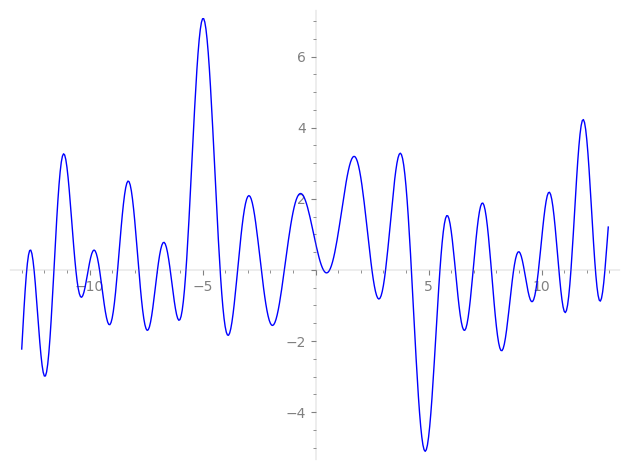| L(s) = 1 | − 2·2-s + 4·4-s + 5i·5-s − 27.7·7-s − 8·8-s − 10i·10-s + 36.7i·11-s + 30.3i·13-s + 55.5·14-s + 16·16-s + 91.9i·17-s + (−38.7 + 73.1i)19-s + 20i·20-s − 73.4i·22-s + 100. i·23-s + ⋯ |
| L(s) = 1 | − 0.707·2-s + 0.5·4-s + 0.447i·5-s − 1.50·7-s − 0.353·8-s − 0.316i·10-s + 1.00i·11-s + 0.646i·13-s + 1.06·14-s + 0.250·16-s + 1.31i·17-s + (−0.467 + 0.883i)19-s + 0.223i·20-s − 0.711i·22-s + 0.909i·23-s + ⋯ |
\[\begin{aligned}\Lambda(s)=\mathstrut & 1710 ^{s/2} \, \Gamma_{\C}(s) \, L(s)\cr =\mathstrut & (-0.892 + 0.451i)\, \overline{\Lambda}(4-s) \end{aligned}\]
\[\begin{aligned}\Lambda(s)=\mathstrut & 1710 ^{s/2} \, \Gamma_{\C}(s+3/2) \, L(s)\cr =\mathstrut & (-0.892 + 0.451i)\, \overline{\Lambda}(1-s) \end{aligned}\]
Particular Values
| \(L(2)\) |
\(\approx\) |
\(0.7583265686\) |
| \(L(\frac12)\) |
\(\approx\) |
\(0.7583265686\) |
| \(L(\frac{5}{2})\) |
|
not available |
| \(L(1)\) |
|
not available |
\(L(s) = \displaystyle \prod_{p} F_p(p^{-s})^{-1} \)
| $p$ | $F_p(T)$ |
|---|
| bad | 2 | \( 1 + 2T \) |
| 3 | \( 1 \) |
| 5 | \( 1 - 5iT \) |
| 19 | \( 1 + (38.7 - 73.1i)T \) |
| good | 7 | \( 1 + 27.7T + 343T^{2} \) |
| 11 | \( 1 - 36.7iT - 1.33e3T^{2} \) |
| 13 | \( 1 - 30.3iT - 2.19e3T^{2} \) |
| 17 | \( 1 - 91.9iT - 4.91e3T^{2} \) |
| 23 | \( 1 - 100. iT - 1.21e4T^{2} \) |
| 29 | \( 1 - 14.9T + 2.43e4T^{2} \) |
| 31 | \( 1 - 114. iT - 2.97e4T^{2} \) |
| 37 | \( 1 - 292. iT - 5.06e4T^{2} \) |
| 41 | \( 1 - 159.T + 6.89e4T^{2} \) |
| 43 | \( 1 - 400.T + 7.95e4T^{2} \) |
| 47 | \( 1 + 35.0iT - 1.03e5T^{2} \) |
| 53 | \( 1 - 19.3T + 1.48e5T^{2} \) |
| 59 | \( 1 + 26.1T + 2.05e5T^{2} \) |
| 61 | \( 1 + 25.1T + 2.26e5T^{2} \) |
| 67 | \( 1 - 617. iT - 3.00e5T^{2} \) |
| 71 | \( 1 - 831.T + 3.57e5T^{2} \) |
| 73 | \( 1 + 768.T + 3.89e5T^{2} \) |
| 79 | \( 1 - 270. iT - 4.93e5T^{2} \) |
| 83 | \( 1 + 348. iT - 5.71e5T^{2} \) |
| 89 | \( 1 + 1.27e3T + 7.04e5T^{2} \) |
| 97 | \( 1 - 1.49e3iT - 9.12e5T^{2} \) |
| show more | |
| show less | |
\(L(s) = \displaystyle\prod_p \ \prod_{j=1}^{2} (1 - \alpha_{j,p}\, p^{-s})^{-1}\)
Imaginary part of the first few zeros on the critical line
−9.557698847596823020080198647496, −8.758577066026932429426849548266, −7.81948274034955618470231554512, −6.99428531589024900059908415107, −6.43151794961651864040488892335, −5.73285800011921906967469589134, −4.22249356802301404639874689928, −3.44842946849509637322085748528, −2.39840374487367594116810639513, −1.38096918290404585915482285222,
0.34483363892633715239288367134, 0.62505214805579323064862043145, 2.49371930718001384069696936557, 3.09758226905373137808744829226, 4.23970592014559592171877184460, 5.50312470246583173886943817596, 6.18514014400356126266365128761, 6.97308250558516640096220553259, 7.77793054829208186017205328841, 8.764070777385908679131636738569

